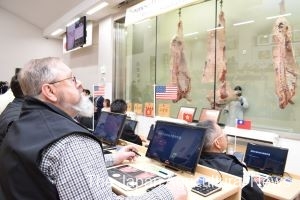HYOGO, March 26 — An auction for overseas buyers seeking premium wagyu beef was held on March 25 at Wagyu Master Meat Center, a meat processing facility in Himeji, Hyogo Prefecture.
More than 100 buyers from 12 countries and regions joined the bidding for carcasses of wagyu beef brands including Kobe beef.
The highest successful bid price was 36,570 yen per kilogram excluding tax.
It was the first time an auction dedicated to foreign buyers was held in Japan.
The Japanese Wagyu World Auction was organized by an organization comprising the meat center, Kobe Beef Marketing & Distribution Promotion Association and S Foods Inc., a meat wholesaler based in Nishinomiya, Hyogo Prefecture.
A carcass of Kobe beef put up by Daichi Yamazaki of Nishiwaki, Hyogo Prefecture, fetched the highest price, auctioned off at 16.8 million yen excluding tax.
The price was the highest level on record for a carcass of Kobe beef, according to officials.
“Enjoy auction,” said S Foods President Shinnosuke Murakami, representing the organizers, in an opening address for the auction which was held in Japanese and English.
Some 130 buyers who do business with the meat center took part in the event. Many were from the United States, Hong Kong, Taiwan, the European Union and Southeast Asia.
Lorenzo Bega, 28, a meat wholesaler from the Philippines, said wagyu is the most famous beef in the world with aroma unlike any other types of beef.
Eighty carcasses of 16 wagyu brands from 12 prefectures, including 20 of Kobe beef and those of other brands such as Omi beef and Matsusaka beef, were showcased at the auction.
A hundred carcasses, selected from some 200 carcasses at a carcass contest held on March 24, were auctioned.
The organizers plan to hold the event around the same time of the year from the next year onwards.


